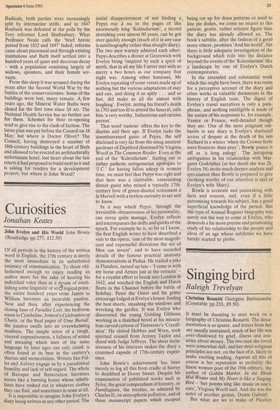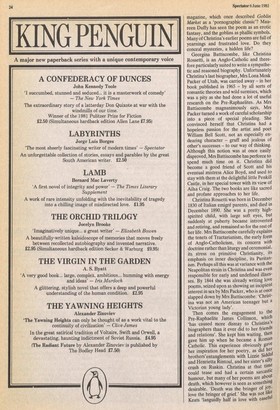Singing bird
Raleigh Trevelyan
Christina Rossetti Georgina Battiscombe (Constable pp.233, £9.50) It must be daunting to start work on a biography of Christina Rossetti. The documentation is so sparse, and letters from her are usually restrained; much of her life was over-shadowed by grief, illness and anxieties about money. The two men she loved were somewhat dull, and her strict religious principles are not, on the face of it, likely to make exciting reading. Against all this of course is her reputation as probably the finest woman poet of the 19th century, the author of Goblin Market, In the Bleak Mid-Winter and My Heart is like a Singing Bird — 'her poems sing like music in one's ears', Virginia Woolf said. And she was the sister of another genius, Dante Gabriel. But what are we to make of Playboy magazine, which once described Goblin Market as a 'pornographic classic'? Maureen Duffy has seen the poem as an erotic fantasy, and the goblins as phallic symbols. Many of Christina's earlier poems are full of yearnings and frustrated love. Do they conceal mysteries, a hidden life?
Georgina Battiscombe, like Christina Rossetti, is an Anglo-Catholic and therefore particularly suited to write a sympathetic and reasoned biography. Unfortunately Christina's last biographer, Mrs Lona Mosk Packer of Utah, was carried away — in her book , published in 1965 — by all sorts of romantic theories and wild surmises, which was a pity as she had done a lot of useful research on the Pre-Raphaelites. As Mrs Battiscombe magnanimously says, Mrs Packer turned a work of careful scholarship into a piece of special pleading. She convinced herself that Christina had a hopeless passion for the artist and poet William Bell Scott, not an especially endearing character — gruff and jealous of other's successes — to our way of thinking. Although this notion was at once easily disproved, Mrs Battiscombe has perforce to spend much time on it. Christina did become a good friend of Scott and his eventual mistress Alice Boyd, and used to stay with them at the delightful little Penkill Castle, in her special tower with its view of Ailsa Craig, The two books are like sacred and profane approaches to her life.
Christina Rossetti was born in December 1830 of Italian emigre parents, and died in December 1890. She was a pretty highspirited child, with large soft eyes, but suddenly at puberty became introverted and retiring, and remained so for the rest of her life. Mrs Battiscombe carefully explains the tenets of Tractarianism, the early form of Anglo-Catholicism, its concern with doctrine rather than liturgy and ceremonial, its stress on primitive Christianity, its emphasis on inner discipline, its Puritanism. Perhaps all this was at variance with the Neapolitan strain in Christina and was even responsible for early and undefined illnesses. By 1844 she was already writing love poems, seized upon as showing an incipient interest in sex by Mrs Packer, who is at once slapped down by Mrs Battiscombe: 'Christina was not an American teenager but a Victorian young lady'. Then comes the engagement to the Pre-Raphaelite James Collinson, which 'has caused more dismay to Christina's biographers than it ever did to her friends and relations'. She kept him waiting, then gave him up when he became a Roman Catholic. This experience obviously gave her inspiration for her poetry, as did her brothers'entanglements with Lizzie Siddal and Henrietta Rintoul, and her sister's sillY crush on Ruskin. Christina at that time could tease and had a certain sarcastic humour, but many of her poems are about death, which however is seen as something desirable. 'Death was the bringer of joY, love the bringer of grief.' She wos not like, Keats 'languidly half in love with easeful death', but saw it as 'an escape from this naughty world' and 'an entry to another and incomparably better one'.
Christina had met Charles Cayley before the publication (1862) of Goblin Market, which made her famous, and came to love him 'more than a little'. As for Goblin Market, it obviously does contain sexual undertones, which could even be subconscious and certainly misconstrued in a permissive age. Mrs Battiscombe must surely be right though in saying that the goblin fruit cannot be equated with actual sexual experience, or with the loss of virginity. If only by observing the behaviour of Dante Gabriel, Christina must have been affected by the fact that her own sexual desires had not been satisfied, but 'if she was preoccupied with eros she was far more preoccupied with agape'. Mrs Battiscombe provides some convincing religious explanations of the poem. Whatever the sexual interpretation, 'the Christian one is closer to Christina's conscious thought'.
Cayley was turned down too, for religious reasons. The last 20 years are full of family tragedies, including Christina's own serious illness and the loss of the looks that are now well known through The Girlhood of Mary Virgin' and 'Ecce Ancilla Domini!' Surprisingly in a way, she admired Swinburne's poetry, even if she had to paste over the anti-God passages in Atalanta. She had to have Lord Henry Somerset's homosexual scandal explained to her, and she was shocked by Gertrude Thomson's nude fairy drawings (which of course appealed to Lewis Carroll). Her death was preceded by terrible screaming fits.
Hidden passions, bottled up secrets, stuffy Victorian rooms, pitiable suitors, self-sacrifice, watching a profligate brother die of drugs: all these await the Lona Mosk Packers. Christina's control resulted in her wonderfully clear and chiselled poems, in beautifully exact images. No wonder so many of these images are concerned not with the complications of city life but with the relief of the countryside's simple delights. Mrs Battiscombe, the biographer of Charlotte Yonge, sees Christina as a typical Charlotte Yonge heroine. Unless a new cache of letters turns up, her approach to Christina is unlikely to be bettered.












































 Previous page
Previous page